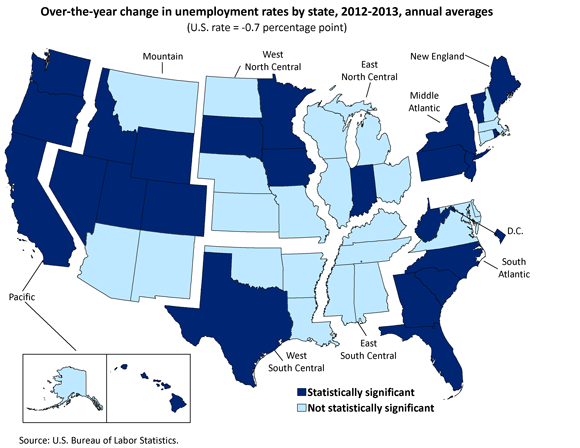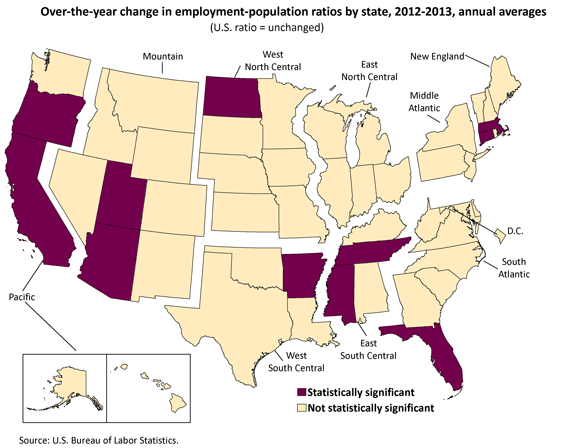An official website of the United States government
 United States Department of Labor
United States Department of Labor
Over the year, 25 states and the District of Columbia had statistically significant unemployment rate changes in 2013, all of which were decreases. Employment-population ratios decreased significantly in 8 states and increased in 3 states. The U.S. jobless rate declined by 0.7 percentage point from the prior year to 7.4 percent, and the national employment-population ratio was unchanged at 58.6 percent.
From 2012 to 2013, the largest statistically significant decreases in unemployment rates were in Nevada (−1.7 percentage points), Florida (−1.6 points), and California (−1.5 points). Six additional states had decreases that were greater than 1.0 percentage point.

| State | 2012 unemployment rate | 2013 unemployment rate | Net change | Statistical significance |
|---|---|---|---|---|
Alabama | 7.1 | 6.5 | -0.6 | Not statistically significant |
Alaska | 6.9 | 6.5 | -0.4 | Not statistically significant |
Arizona | 8.3 | 8.0 | -0.3 | Not statistically significant |
Arkansas | 7.5 | 7.5 | 0.0 | Not statistically significant |
California | 10.4 | 8.9 | -1.5 | Statistically significant |
Colorado | 7.8 | 6.8 | -1.0 | Statistically significant |
Connecticut | 8.3 | 7.8 | -0.5 | Not statistically significant |
Delaware | 7.1 | 6.7 | -0.4 | Not statistically significant |
District of Columbia | 9.1 | 8.3 | -0.8 | Statistically significant |
Florida | 8.8 | 7.2 | -1.6 | Statistically significant |
Georgia | 9.0 | 8.2 | -0.8 | Statistically significant |
Hawaii | 5.7 | 4.8 | -0.9 | Statistically significant |
Idaho | 7.3 | 6.2 | -1.1 | Statistically significant |
Illinois | 8.9 | 9.2 | 0.3 | Not statistically significant |
Indiana | 8.1 | 7.5 | -0.6 | Statistically significant |
Iowa | 5.2 | 4.6 | -0.6 | Statistically significant |
Kansas | 5.8 | 5.4 | -0.4 | Not statistically significant |
Kentucky | 8.3 | 8.3 | 0.0 | Not statistically significant |
Louisiana | 6.5 | 6.2 | -0.3 | Not statistically significant |
Maine | 7.2 | 6.7 | -0.5 | Statistically significant |
Maryland | 6.9 | 6.6 | -0.3 | Not statistically significant |
Massachusetts | 6.8 | 7.1 | 0.3 | Not statistically significant |
Michigan | 9.1 | 8.8 | -0.3 | Not statistically significant |
Minnesota | 5.6 | 5.1 | -0.5 | Statistically significant |
Mississippi | 9.2 | 8.6 | -0.6 | Not statistically significant |
Missouri | 7.0 | 6.5 | -0.5 | Not statistically significant |
Montana | 6.0 | 5.6 | -0.4 | Not statistically significant |
Nebraska | 4.0 | 3.9 | -0.1 | Not statistically significant |
Nevada | 11.5 | 9.8 | -1.7 | Statistically significant |
New Hampshire | 5.5 | 5.3 | -0.2 | Not statistically significant |
New Jersey | 9.3 | 8.2 | -1.1 | Statistically significant |
New Mexico | 7.1 | 6.9 | -0.2 | Not statistically significant |
New York | 8.5 | 7.7 | -0.8 | Statistically significant |
North Carolina | 9.2 | 8.0 | -1.2 | Statistically significant |
North Dakota | 3.0 | 2.9 | -0.1 | Not statistically significant |
Ohio | 7.4 | 7.4 | 0.0 | Not statistically significant |
Oklahoma | 5.4 | 5.4 | 0.0 | Not statistically significant |
Oregon | 8.8 | 7.7 | -1.1 | Statistically significant |
Pennsylvania | 7.9 | 7.4 | -0.5 | Statistically significant |
Rhode Island | 10.3 | 9.5 | -0.8 | Statistically significant |
South Carolina | 9.0 | 7.6 | -1.4 | Statistically significant |
South Dakota | 4.2 | 3.8 | -0.4 | Statistically significant |
Tennessee | 8.2 | 8.2 | 0.0 | Not statistically significant |
Texas | 6.8 | 6.3 | -0.5 | Statistically significant |
Utah | 5.4 | 4.4 | -1.0 | Statistically significant |
Vermont | 4.9 | 4.4 | -0.5 | Statistically significant |
Virginia | 5.9 | 5.5 | -0.4 | Not statistically significant |
Washington | 8.1 | 7.0 | -1.1 | Statistically significant |
West Virginia | 7.2 | 6.5 | -0.7 | Statistically significant |
Wisconsin | 6.9 | 6.7 | -0.2 | Not statistically significant |
Wyoming | 5.4 | 4.6 | -0.8 | Statistically significant |
Nevada again had the highest unemployment rate (9.8 percent) in 2013, followed by Rhode Island (9.5 percent) and Illinois (9.2 percent). North Dakota had the lowest jobless rate among the states for the fifth year in a row (2.9 percent), followed by South Dakota (3.8 percent) and Nebraska (3.9 percent). Overall, 25 states had unemployment rates that were significantly lower than the U.S. rate of 7.4 percent, while 11 states and the District of Columbia had rates significantly above it.
From 2012 to 2013, the largest employment-population ratio decrease among the states occurred in Tennessee (−1.1 percentage points), followed by Arkansas and North Dakota (−1.0 point each). Five other states also had statistically significant decreases in their ratios. Utah had the largest increase in its employment-population ratio among the states (+1.4 percentage points). California and Florida had the only other statistically significant increases in their ratios over the year (+0.5 percentage point each).

| State | 2012 employment-population ratio | 2013 employment-population ratio | Net change | Statistical significance |
|---|---|---|---|---|
Alabama | 53.6 | 53.1 | -0.5 | Not statistically significant |
Alaska | 63.6 | 63.4 | -0.2 | Not statistically significant |
Arizona | 55.5 | 54.6 | -0.9 | Statistically significant |
Arkansas | 54.9 | 53.9 | -1.0 | Statistically significant |
California | 56.5 | 57.0 | 0.5 | Statistically significant |
Colorado | 63.4 | 63.2 | -0.2 | Not statistically significant |
Connecticut | 60.9 | 60.1 | -0.8 | Statistically significant |
Delaware | 56.9 | 56.7 | -0.2 | Not statistically significant |
District of Columbia | 63.0 | 63.5 | 0.5 | Not statistically significant |
Florida | 55.3 | 55.8 | 0.5 | Statistically significant |
Georgia | 58.0 | 57.9 | -0.1 | Not statistically significant |
Hawaii | 57.7 | 57.7 | 0.0 | Not statistically significant |
Idaho | 60.0 | 60.1 | 0.1 | Not statistically significant |
Illinois | 59.9 | 59.4 | -0.5 | Not statistically significant |
Indiana | 57.9 | 58.0 | 0.1 | Not statistically significant |
Iowa | 66.0 | 66.3 | 0.3 | Not statistically significant |
Kansas | 64.4 | 64.3 | -0.1 | Not statistically significant |
Kentucky | 56.2 | 55.7 | -0.5 | Not statistically significant |
Louisiana | 55.5 | 55.9 | 0.4 | Not statistically significant |
Maine | 60.6 | 60.9 | 0.3 | Not statistically significant |
Maryland | 63.3 | 63.0 | -0.3 | Not statistically significant |
Massachusetts | 60.6 | 60.1 | -0.5 | Statistically significant |
Michigan | 54.5 | 55.0 | 0.5 | Not statistically significant |
Minnesota | 66.8 | 66.8 | 0.0 | Not statistically significant |
Mississippi | 52.9 | 52.0 | -0.9 | Statistically significant |
Missouri | 59.7 | 60.1 | 0.4 | Not statistically significant |
Montana | 60.2 | 60.5 | 0.3 | Not statistically significant |
Nebraska | 69.3 | 69.2 | -0.1 | Not statistically significant |
Nevada | 57.5 | 57.2 | -0.3 | Not statistically significant |
New Hampshire | 65.8 | 65.6 | -0.2 | Not statistically significant |
New Jersey | 59.4 | 59.4 | 0.0 | Not statistically significant |
New Mexico | 54.1 | 54.1 | 0.0 | Not statistically significant |
New York | 56.6 | 56.8 | 0.2 | Not statistically significant |
North Carolina | 57.0 | 56.9 | -0.1 | Not statistically significant |
North Dakota | 70.4 | 69.4 | -1.0 | Statistically significant |
Ohio | 58.9 | 59.0 | 0.1 | Not statistically significant |
Oklahoma | 58.7 | 58.8 | 0.1 | Not statistically significant |
Oregon | 57.3 | 56.7 | -0.6 | Statistically significant |
Pennsylvania | 58.6 | 58.8 | 0.2 | Not statistically significant |
Rhode Island | 59.4 | 59.3 | -0.1 | Not statistically significant |
South Carolina | 54.4 | 54.4 | 0.0 | Not statistically significant |
South Dakota | 67.5 | 67.2 | -0.3 | Not statistically significant |
Tennessee | 56.7 | 55.6 | -1.1 | Statistically significant |
Texas | 60.9 | 61.1 | 0.2 | Not statistically significant |
Utah | 64.2 | 65.6 | 1.4 | Statistically significant |
Vermont | 66.2 | 65.5 | -0.7 | Not statistically significant |
Virginia | 62.9 | 62.7 | -0.2 | Not statistically significant |
Washington | 59.6 | 59.1 | -0.5 | Not statistically significant |
West Virginia | 50.3 | 50.1 | -0.2 | Not statistically significant |
Wisconsin | 63.5 | 63.6 | 0.1 | Not statistically significant |
Wyoming | 65.1 | 64.9 | -0.2 | Not statistically significant |
West Virginia again had the lowest employment-population ratio among the states, 50.1 percent in 2013. West Virginia has had the lowest employment-population ratio each year since the series began in 1976. Four states in the West North Central division again had the highest ratios: North Dakota (69.4 percent), Nebraska (69.2 percent), South Dakota (67.2 percent), and Minnesota (66.8 percent). Overall, 22 states and the District of Columbia had employment-population ratios that were significantly above the U.S. ratio of 58.6 percent, and 18 states had ratios that were appreciably below it. Three states had the lowest employment-population ratios in their series in 2013: Delaware, 56.7 percent; Nevada, 57.2 percent; and Oregon, 56.7 percent.
These data are from the Local Area Unemployment Statistics program. The employment-population ratio is the proportion of the civilian noninstitutional population 16 years of age and over with a job. To learn more, see "Regional and State Unemployment — 2013 Annual Averages" (HTML) (PDF), news release USDL-14-0315.
Bureau of Labor Statistics, U.S. Department of Labor, The Economics Daily, Significant declines in unemployment rates for 25 states and the District of Columbia, 2012-2013 at https://www.bls.gov/opub/ted/2014/ted_20140304.htm (visited January 11, 2026).

